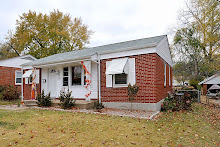HGTV has recently rolled out FrontDoor, which is essentially just a fancy name for their real estate section of their website. They had the following list on there recently:
Like Wall Street, the real estate industry is feeling the painful effects of loose lending practices and bad mortgage loans. Now, more than ever, prospective homebuyers and sellers should be aware about what's happening with the housing market -- and where it's headed -- in order to make smart decisions. In addition to understanding what fueled the current financial crisis and the government's bailout of mortgage giants Fannie Mae and Freddie Mac, get familiar with FrontDoor's top 10 trends in real estate.
1. Homes in foreclosure reach record highs
While some markets have started to show improvement, the number of homes in foreclosure continues to rise to unprecedented levels. According to a report from the Mortgage Bankers Association, a record 1.2 million homes were in foreclosure in the second quarter of 2008. This number is expected to reach 2 million by the end of the year, analysts say.
2. Home prices continue to fall
But because real estate is local, the rate of decline varies on your market. And in some high-demand markets, prices are still climbing, though at a slower rate. According to the Case-Shiller Index -- a survey of home prices in 20 major metropolitan areas -- prices nationwide fell 15 percent in the second quarter of 2008 compared with last year. Despite the national numbers, some regions are starting to make a comeback. Some say the trend in falling home prices will mean lower divorce rates because a couple is less willing to sacrifice their equity.
3. Borrowers will have a harder time getting a mortgage
During the housing boom, mortgages were easy to come by -- too easy to come by. Risky lending practices have come back to bite companies who profited from millions of bad loans, and many mortgage companies (including industry giants Countrywide, Fannie Mae and Freddie Mac) and financial giants Lehman Brothers and AIG have fallen apart. As a result, U.S. banks have tightened their lending standards, limiting non-traditional loans such as interest-only mortgages and getting rid of subprime mortgages.
4. Bad real estate agents will get weeded out
In the past, homes practically sold themselves, and enterprising people became part-time real estate agents. Nowadays, home sellers are looking for premium service and expertise from Realtors in exchange for the 6 percent commission. And savvy buyers want an agent who offers insight and knowledge not available on the Internet. So be selective -- only the best Realtors will succeed in this market.
5. Mortgage rates are still at historic lows.
After the government bailout of Fannie Mae and Freddie Mac, rates of 30-year fixed rate mortgages plunged from 6.35 percent to 5.93 percent in a week, the biggest weekly drop in more than 28 years. However, some analysts believe mortgage rates will rise if the government has to borrow money to finance Fannie Mae and Freddie Mac. But remember before the 1990s, interest rates were in the double digits.
6. Urban areas are making a comeback
The U.S. experienced a mass exodus to the 'burbs after World War II, but homebuyers are now regaining interest in downtown areas. Urban core homes are often more expensive per square foot than their suburban counterparts, but many buyers are willing to pay a premium to avoid long commutes and urban sprawl.
7. Bigger is not always better
While the size of the average American family shrunk from 3.1 people in 1974 to 2.6 people in 2004, the size of the average American home increased from 1,695 square feet to 2,349 square feet. However, many homebuyers looking to save money on utilities, taxes and maintenance are now foregoing McMansions and instead opting for smaller homes.
8. Buyers are going green
Eco-friendly attributes such as radiant floor heating systems, Energy Star rated appliances and on-demand water heating units are all the rage with homebuyers right now. For sellers, promoting your home's green features will give you an edge in the competitive market.
9. Technology and social networking are changing how we buy and sell homes
Listings, home valuations and other information previously only available through real estate agents are now available on the Web. Because of this, agents have had to rethink their roles in the real estate world and adapt to the times. For buyers and sellers, more technology means alternatives to the traditional route of selling through an agent, such as home swapping and online auctions.
10. Flipping is out, buying and holding is in
Falling prices and a large inventory of unsold homes mean there are more potential bargains out there. Real estate investors are taking advantage of current conditions, knowing that a down market is the best time to get a good deal.
Wednesday, October 1, 2008
Subscribe to:
Post Comments (Atom)






No comments:
Post a Comment